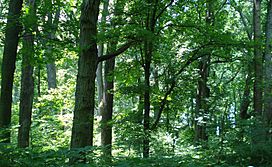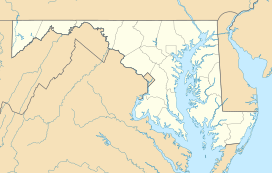Belt Woods facts for kids
Quick facts for kids Belt Woods |
|
|---|---|
 |
|
| Area | 43 acres (17 ha) |
| Geography | |
| Country | United States |
| State | Maryland |
| District | Prince George's County |

Belt Woods is a special nature reserve in Prince George's County, Maryland, U.S. It has a part called the "South Woods." This area is about 43-acre (170,000 m2) big. It is one of the last places with very old hardwood trees on the Atlantic coastal plain.
Belt Woods is only about 8 miles (13 km) east of Washington, D.C.. Many of its white oaks and tulip poplar trees are huge. They are more than three feet wide. They also grow over 100 feet (30 m) tall before their branches start. In 1974, the "South Woods" became a National Natural Landmark. This means it is a very important natural place.
The Maryland Department of Natural Resources has owned Belt Woods since the 1980s. They work to keep it safe. About 110 acres (0.45 km2) of the site is a Natural Environment Area. Another 515 acres (2.08 km2) is a Heritage Conservation Fund site. This means a total of 625 acres (2.53 km2) is protected. Most of this land, 610 acres (2.5 km2), is a special Maryland Wildland.
Contents
History of Belt Woods
Belt Woods was once part of a large farm. This farm belonged to a man named Seton Belt (1870–1959). He was a banker and also loved farming. In 1947, experts studied the birds living there. They found many Forest Interior Dwelling Species (FIDS) birds. These are birds that need large forests to live.
Seton Belt came from a family that settled in Prince George's County in the 1600s. He owned 3,200 acres of land, including these woods. In his will, written in 1944, he made a special request. He said the trees on his home farm should never be cut down. He also said his 624-acre home farm should never be sold. He wanted money from his other lands to help a church.
In 1976, the church and the bank managing his will asked the court for a change. They were allowed to sell and cut down trees on the farm.
Protecting the Forest
In 1981, a company cut down many old oak and tulip trees. These trees were used for veneer. Veneer is a thin layer of wood used to cover furniture or walls. This event made many people worried about the forest.
A long legal fight started between conservation groups and the church. In 1984, the state of Maryland bought 110 acres (0.45 km2) of the land. This included the "South Woods." They named it the Belt Woods Natural Environmental Area.
Later, in 1997, more land was bought to stop houses from being built there. This added 515 acres (2.08 km2) more land. This area is called the Belt Woods Heritage Conservation Fund site. It includes the "North" and "Central Woods," which are now young forests and open fields. This land helps protect the old-growth forest.
In total, about 625 acres (2.53 km2) of Belt Woods is now protected. Most of this land, 610 acres (2.5 km2), was named the Belt Woods Wildland in 1997. People can only visit Belt Woods for scientific study.
Nature at Belt Woods
Forest Animals
Belt Woods is part of the Southeastern mixed forests area. It has different types of land, like small fields and woodlands. It is a very important place for neotropical songbirds to build their nests. Many birds that live deep inside forests, called FIDS birds, are found here.
In 1989, a study found over 200 pairs of FIDS birds per 100 acres. This was because of many wood thrush and red-eyed vireo birds. Nine other types of FIDS birds also live and breed here regularly. This includes the Kentucky warbler.
Plants and Trees
The top layer of trees, called the canopy, in Belt Woods is mostly tulip poplar and white oak trees. Some trees are 200 years old and over 140 feet tall. In 2001, 42 different kinds of trees were found in the "South Woods."
Smaller trees that grow under the canopy include flowering dogwood, spicebush, and ironwood. The ground layer of plants is very thick in spring. It has plants like Collinsonia, Dioscorea, and broad beechfern. Two types of ferns, the narrowleaf glade fern and Wister's coralroot, also grow here. These are special because they are threatened species in Maryland.



